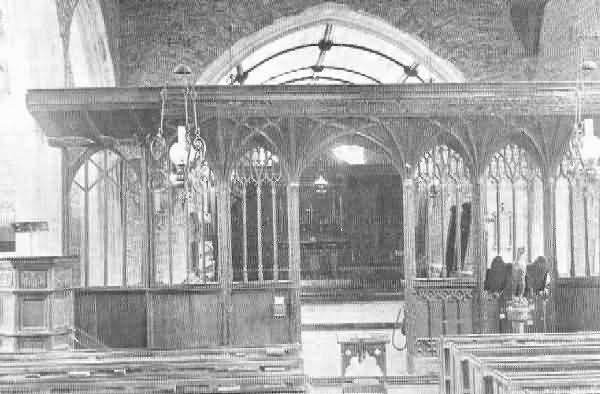
«SOME OLD DEVON CHURCHES» BY JOHN STABB; 13-24
Bampton [13]; Beer Ferrers [14]; Berry Pomeroy [15]; Bickington, High [16]; Bickleigh - Tiverton [17]; Bideford [18]; Bishop's Tawton [19]; Bishopsteignton [20]; Blackawton [21]; Black Torrington [22]; Bondleigh [23]; Bovey Tracey [24].
BAMPTON. St. Michael and All Angels. The church consists of chancel, nave, north aisle, south porch, and embattled western tower containing six bells. The chancel is of the Decorated period and the nave of five bays of the Perpendicular. The rood screen [plate 13] dates from about 1450, it is well carved, and on the fan tracery may be seen the Bourchier badge. It retains its groining on both sides, but the paintings on the lower panels have been obliterated. The whole screen is sadly in need of restoration. In the tower is a screen which at one time formed part of the screen in St. Mary's Church, Taunton [Somerset].
Affixed to the north and south walls of the chancel are the sides and ends of two or more tombs of grey marble, they are richly ornamented with traceried panels, with shields in the centre, but the brasses are gone. Dr. Oliver has the following account of these tombs:— "How such elaborate work came to be placed there not a little perplexed me, but the Venerable Bartholomew Davey, the vicar, resolved my perplexity by informing me that it belonged to two monuments of considerable antiquity which stood in the chancel, and that on their removal about forty years ago the sides were placed to line the walls. That they covered the remains of Sir John Bourchier, Knt., Lord Fitzwarren, created Earl of Bath, July 9th 1536, and of his father, is certain. The will of the former bearing date 20th October 1535, and proved 11th June 1541, expressly directs his body to be buried in the parish church of Bampton, Devon, in the church where his father was buried, with his picture, arms, and cognizance, and the day and year engraven and fixed on the same tomb within a year after his decease. One of the skeletons was described to me as being of gigantic proportions." The father of Sir John Bourchier was Fulk Bourchier, Lord Fitzwarren, he was the son of William Bourchier and Thomasine Hankford. Dugdale, quoting the will of Fulk Bourchier, shows that his father, William Bourchier, and his mother, Thomasine Hankford, are also buried at Bampton, as he bequeathed his body to be buried at Bampton near the grave of his mother, Lady Thomasine, and he willed that marble stones with inscriptions should be placed on his own grave and that of his father, Lord William, and his mother, Lady Thomasine.
The registers date from 1653, but are very imperfect.
BEER FERRERS [or BERE FERRERS.] St. Michael. The church [plate 14a] consists of chancel, nave, north and south transepts, south aisle, south aisle chapel, south porch, and west tower — cut off from the nave — containing six bells, dated 1775.
Dr. Oliver says, in Monasticon Dioecesis Exoniensis, p. 289:— "Sir William de Ferrariis having rebuilt the parish church was desirous of making it collegiate. For this purpose he assigned a sufficient endowment for an arch-priest, and four other clergymen in priest's orders who were to live in common under the same roof. Provision was also made for an assistant deacon, a sub-deacon or at least a clerk. The community were to perform the daily and nightly office in the church and to offer up perpetual prayers for the prosperity of the founder and his lady, Matilda, during their lives, and for their souls after their death, as also for the souls of Reginald de Ferrers and his wife Margery, and the souls of Sir Roger de Carminow, Knt., and his lady Joan; and the bishops of Exeter were to be remembered, both living and dead. Bishop Grandisson and the Dean and Chapter of his cathedral approved and confirmed this foundation in 1333-4, but secured the yearly payment therefrom of 20s. for the chorister boys of the cathedral. The founder did not long survive his charitable work, for we find in Bishop Grandisson's Register, Vol. 2, folio 219, that his relict and executrix Matilda, obtained from the Bishop, on December 15th, 1338, an acknowledgement of having well and faithfully administered to her late husband's property, and that only the sum of £20 in arrear ad comletionem cantarie de Biry."
On the north side of the chancel is the tomb of the founder of the church [plate 14b], an earlier Sir William, and his wife Isolda, who probably built or rebuilt the church about the year 1243. The recumbent figures lie beneath an arch highly ornamented and carved, with angels swinging censers, angels' faces, foliage, etc. The male figure is arrayed in chain armour, with a coiffe de maille drawn tightly over the head, a style which continued in use until the reign of Edward III [1327-1377]. The legs are crossed, but are very much mutilated; there is a shield on the left arm suspended by a belt across the right shoulder, both hands rest on the sword, the scabbard of which is missing. The female has a coverchief on the head and hanging down the back of the neck, it is confined by a fillet round the forehead; the throat, chin, and sides of the face are covered with a wimple, the body of the dress is tight-fitting with a long flowing skirt. The hands, which rest on the breast, and the feet, have been broken off. In the east chancel window is some old stained glass with figures probably representing the occupiers of the tomb beneath. The male figure holds a church in his hands, and over his head is the inscription:— Wills Fereys me fecit.
Behind the altar is a large slab of Purbeck marble, with three large panels of wheel tracery, surrounded by a border of small quatrefoils, each wheel has a hole in the centre as if for a spindle, but as the three wheels are all carved in one block of stone this must have been impossible. There is, I believe, beneath the altar another stone carved with foliage, but this is now hidden by a wooden platform on which the altar stands. On the floor of the chancel, near the Ferrers' tomb, is a brass tablet with the inscription:—
Near this spot |
He was engaged in making a drawing of the stained glass, for the Rev. D. Lysons, when he fell off the ladder and was killed. He is buried just outside the east window. On the south side of the chancel are sedilia, and piscina with remains of shelf. There is a piscina in the aisle chapel and also in the north and south transepts. Beneath an arch under the window, in the north transept, is an effigy of a knight much mutilated. It is supposed to represent one of the Ferrers family. The armour is probably rather earlier than that of the effigy in the chancel. The legs, below the knees, have been broken off, his shield rests on his breast, both hands grasp the sword hilt, and the head, which rests on a helmet, and body are encased in chain armour. In the transept is an altar tomb of Purbeck marble; around the sides in panels are shields without arms, the cover stone is plain, but there is a deeply sunk indent around its edge which originally held the inscription on brass; the date is probably about 1520, and it is thought to be the tomb of the second Lord Willoughby de Broke. Against the west wall of the transept is an old gravestone with a Calvary cross, with the Sacred Heart and Monogram, it is supposed to mark the burial place of Roger Champernowne, son of Alexander Champernowne, of Modbury, the inscription is:—
Hic jacet Roger Champernowne, armiger, |
From this transept there is a broad hagioscope into the chancel, and on the west side a large fireplace.
The bench-ends are old, but with the exception of two they are all carved with geometrical patterns. At the east end of the aisle one of the bench-ends is carved with the arms of the Ferrers family, five rudders, and four horseshoes. On another is the achievement of Willoughby de Broke.
There are 14 or 15 of the lower panels of the rood screen remaining, with painted figures, but these are so defaced it is difficult to name them. One is probably St. Sidwell. They are of unusually early date. There is an old font bearing the appearance of having been carved out of the capital of a pillar turned upside down [plate 14c], but possibly the idea of the carving may have been taken from a capital. The porch has a flat oak roof with carved bosses at the intersections of the ribs.
In the churchyard, near the east window, is a gravestone with the following inscription:
—
Here lyeth the body of Walter Pyke, who |
Mr. Pyke evidently had no great faith in doctors!
The registers date: baptisms, 1538; marriages, 1538; burials, 1539.
BERRY POMEROY. St. Mary. The church consists of chancel, nave, north and south aisles, south porch with parvise, and embattled western tower containing four bells, dated 1635, 1829, 1750, 1607. The building, which is chiefly Perpendicular in style, with remains of Early English and Decorated work, was rebuilt in the 15th century, possibly by Sir Richard de Pomeroy.
The principal monuments are those of the Pomeroys and Seymours. In the north wall of the chancel is the tomb of Sir Richard Pomeroy, and Elizabeth his wife, 1501. In the north wall of the chapel at the east end of the aisle is a fine monument [plate 15], erected to the memory of Lord Edward Seymour, the son of the Protector [Edward, ca. 1505-1552; acceded 1546], who died in 1593, and his daughter-in-law, Elizabeth, daughter of Arthur Champernowne. The arch is ornamented with roses and pomegranates; beneath the arch lie the knights, clothed in plate armour, one above the other; below lies the lady, behind her head a cradle with a child in it, and at her feet a figure in a chair. On the panel beneath are the kneeling figures of the nine children, five male and four female.
In the chancel is a tablet to the memory of the Rev. John Prince, author of Worthies of Devon, who was vicar of the parish for 42 years, and died in 1723.
The rood screen is 42 feet long [plate 15b], the doors are missing, and the cresting and parts of the cornice are in a bad state, but it is going through the process of restoration. Among the saints on the panels are St. James the Less, St. Thomas, St. Stephen, St. Jude, St. Matthias, St. Mary Magdalene, St. Barbara, and the four Doctors of the Church [St. Gregory the Great, St. Ambrose, St. Augustine, and St. Jerome]. The south aisle portion has been completed, and when I visited the church the north aisle part had been removed, and I believe the complete restoration of the screen is now being carried out by the same firm that restored the screen of Down St. Mary.
On the capitals of the piers on the north side of the nave are scrolls bearing the names of some persons and their wives who contributed to the building of that part of the church. The south porch has a groined roof with bosses, bearing the arms of the Pomeroy family.
The registers date from 1602.
BICKINGTON, HIGH. St. Mary. Risdon says the original church "was founded by King Athelstan [r. 925-940], who gave to God and it one hide of land, as appeareth by the donation, a copy whereof, for the antiquity thereof, I will here insert:—John Athelstan, King, grome of this home, give and graunt to the priest of this church, one yoke of mye land frelith to holde, woode in my holt house to build, with grass for all hys beasts, fuel for his hearth, pannage for hys sowe and piggs world without end."
The present building [plate 16a], dating from the 15th century, consists of chancel, nave, north aisle, south porch, and west tower with six bells.
The font and south porch are Norman. In the chancel are sedilia, piscina, and priest's door. On the south side of the nave is the vestry occupying the base of what was originally the tower, but the upper part of the tower was pulled down and a west tower built many years since. There was at one time a west gallery, but this has been removed. When the gallery was taken down some of the old bench-ends at the lower end of the church were brought from farmhouses in the neighbourhood and erected at the west end of the nave. The series of bench-ends is remarkably fine, most of them being carved with figures of saints:— St. Peter with the key; St. Paul with the sword; St. Andrew with his cross; a figure with staff, wallet, and shell, St. James the Great (?); a male figure with staff and rosary, St. Sebald (?); a male figure with a club, St. James the Less (?); and a figure with the hair apparently dressed in a pigtail, the hands raised in the attitude of prayer.
The Norman font has been restored [plate 16b]; it was in a very dilapidated condition, only kept together by bolts of iron. A remarkable feature is its being composed of only two blocks of stone, the square base and half the shaft being cut out of one block, and the bowl and the other half of the shaft are cut out of the second block. The bowl, which takes the form of a cushioned capital, is well carved, and there is cable moulding around the base of the shaft.
The registers date: baptisms, 1707; marriages 1754; burials, 1707.
BICKLEIGH - TIVERTON. St. Mary. The church consists of chancel, nave, south aisle, separated from the nave by four arches, the capitals being carved with different designs, south porch, and west tower with six bells. The church is noted for its monuments of the Carew family, and churchyard as being the burial place of Bampfylde Moore Carew.
Against the east end of the wall of the south aisle is the monument [plate 17a] of Elizabeth Eriseyes with the following inscription:—
"Carew's daughter Eriseyes wife
Elizabeth that hight
Exchanged life for death to give
A sonne this world's light
To God she lived to God she died
Young yeered in virtues old
And left until it rise again
This tombe her corps to hold.
Ano. Do. 1618."
On the north side of the chancel is an altar tomb of John Carew, Esq., of Bickleigh, died 1588, who married a daughter of Gilbert St. Clare of East Budleigh. Above this tomb is a mural monument with a kneeling figure of a man in half armour and trunk hose, and also the figure of a child. There is no inscription, but over the monument are the Carew arms. At the east end of the aisle is the monument [plate 17b] of Sir Henry Carew who died in 1681. He is arrayed in full plate armour, the head with long hair resting on a cushion. Above him reclines his wife arrayed in frilled headdress, tight bodice with full sleeves, and full skirt. Her head rests on her right hand and her left hand holds a book. The two daughters kneel, the one at the head and the other at the feet of their father. On the wall near the south door is the monument, with busts, of Peter Carew, died 1634, and Elizabeth (Chudley) his wife, died 1619.
There are some old bench-ends and an old font of unusual shape.
The registers date: baptisms, 1570; marriages, 1571; burials, 1569.
BIDEFORD. St. Mary. The church consists of chancel, nave, north and south aisles, transept, north and south porches, and tower containing eight bells, six of which date from 1772. The present building is modern, having (with the exception of the tower) been entirely re-built in 1865. It is a fine church, but one regrets that so little of the ancient building was preserved. The old fluted granite columns, the corbel heads, carved bench-ends, etc., were handed over to the builder, and some years afterwards were sold, the oak being split up for firewood, and the granite pillars used as gateposts for the suburban villas. What was saved of the old oak has been made into a belfry screen, and the richness of the carving makes one doubly regret the taste (?) of those who could prefer pitch pine seats to the ancient oak.
The Norman font [plate 18a], saved from the old church, is circular in shape with double rows of cable moulding and carved panels on the bowl; it is supported on a shaft with cable moulding round the base.
On the south side of the chancel is the monument of Sir Thomas Grenville [plate 18b], died March 18th 1513, with his effigy in armour. On the tomb are shields of arms of Grenville, and Grenville impaling Gilbert, this knight having married Isabel, daughter of Otho Gilbert, of Compton Marldon. Mr. W. H. Hamilton Rogers, in his Sepulchral Effigies in the Parish Churches of North Devon, gives the following account of the figure of the knight:— "The pauldrons and coudiéries are ornamented, and the brassarts and vambraces puffed or ribbed. Taces to which are appended deep lambeaux of overlapping plate, large apron of chain mail, and broad-toed sabbatons, complete his costume, and he is armed with sword and misericorde." On his breast hangs a double chain. The head of the effigy is, in accordance with a practice adopted towards the end of the 15th century with armed figures, bare; it rests on a tilting helmet, out of which is issuant a small shield charged with the Grenville arms (three horseman's rests). In his hands he holds his heart, an occurrence also frequent with mediæval figures. At his feet are two half dogs conjoined. Over the figure is an arch with screen work, the top of which is mutilated, and on the frieze of the monument is the following inscription in black letters:—
Hic jacet Thomas Graynfyld miles patron isti
eccle q obiit xviii die mensis marcii A.D.
Mcccccxiii cuy aie ppiciet de. Amen.
Below the effigy on the tomb on either side are shields displaying his arms and those of his first wife (on a chevron three roses), and two canopied niches for the figures of saints. This monument had been stored away in the crypt as being out of keeping with a new church, but has now been reconstructed and placed in its original position.
The date of the former church is unknown, but it is believed to have been Early Norman, when it was pulled down remains of a smaller, and probably Saxon, building were found.
In the churchyard is the following curious epitaph:—
"Here lies the body of Mary Sexton,
Who pleased many a man, but ne'er vext one,
Not like the woman who lies under the next stone."
The registers date from 1561.
BISHOP'S TAWTON. St. John the Baptist. The church is Perpendicular, and consists of a chancel, nave, north aisle, south porch, and on the north side a tower surmounted by a spire containing six bells, dating from 1803 to 1852. The spire is much disfigured by the flue of the heating apparatus. I suppose, for a modern congregation, some plan for heating the church is necessary, but it seems a pity some means cannot be found for getting rid of the smoke without spoiling the outward appearance of the building. The rood screen has been removed, but a portion has been used as a screen for the north chancel aisle [plate 19], which is now used as an organ chamber. It consists of three bays with arcaded heads and flat spandrels instead of groining, filled with carving of foliage. Between the cusping of the heads of the lower panels is carved the Rose in splendour.
Near the church are the remains of the episcopal residence of the Bishops of Exeter.
The registers date: baptisms, 1558; marriages, 1587; burials, 1587.
BISHOPSTEIGNTON. St. John the Baptist. The church consists of chancel, nave, north aisle separated from nave by arches supported on fluted columns with carved capitals. There is a priest's door in the chancel and a piscina at the east end of the aisle, but this is not now visible, as it is hidden by the organ. On the north wall of the chancel is the memorial of Peter Lear de Lyndridge, Bart., 1682, and on the north wall of the aisle is the memorial of the Martyn family of Lyndridge, dated 1676. The west tower was rebuilt in 1815, but the west doorway is old and is an excellent example of Norman work [plate 20a]. It has grotesque heads of birds and beasts, with chevron and other mouldings, the beasts' head, etc., are carved round the arch of the doorway; the capitals of the pillars at the sides are well carved with figures and foliage.
On the south wall is another Norman carving [plate 20b]; this originally formed the tympanum of the south door, but the doorway has been walled up; we must be thankful that the carving was not removed at the same time. It represents the Adoration of the Magi, and the figures of the Wise Men are in a very good state of preservation.
The font is Norman with a narrow band of carving round the edge of the bowl, a broader band lower down, then cable moulding, and a scallop pattern round the shaft [plate 20c].
At the east end of the churchyard are some old tombs where lie buried those who died of the plague in the 17th century.
The registers date from 1558.
BLACKAWTON. St. Michael. The church is Perpendicular, and consists of chancel, nave, north and south aisles, south porch, and embattled western tower containing six bells, five of which were recast in 1782. The chancel portion of the rood screen remains [plate 21a], but is sadly in need of restoration. It retains traces of ancient colour, and the panels have shields with emblems of the Passion and paintings of arabesque pattern. The south parclose screen is richly carved.
The ancient double piscina and sedilia remain in the chancel [plate 20b]. Sedilia is the name for the three stone seats which are often found on the south side of the church near the altar. The usual number of the seats is three, and they were used by the priest, deacon, and sub-deacon at High Mass. They are generally graduated, but sometimes are on the same level. At Blackawton the floor of the chancel must have been considerably raised; if the seats were used now, they would be uncomfortably low.
Piscina is the name given to the shallow basin or drain found in the south wall of the chancel of many of old churches. They are sometimes single and sometimes double. When there are two basins side by side, one was used for the disposal of the water used by the priest for washing his hands, and the other for the water used for the cleansing of the sacred vessels. In the 14th century it became the custom for the celebrant to drink the ablutions, and a single piscina was sufficient. Examples of most periods of architecture will be found — Norman, Early English, and Perpendicular, but Norman are rare. In some cases they are very plain and in others highly ornamented.
In the aisle there is a fine brass to the memory of Nicholas Forde, of Forde, died 1582, and his wife Margaret.
The font [plate 21c] is Norman with circular bowl; there is cable moulding round the top, and beneath, a band of carving. It is mounted on shaft and plinth. On some of the capitals of the pillars will be found the arms of Torre Abbey, which possessed large estates in the parish. The church, with the exception of the chancel, was restored in 1887. In 1893 the church was again restored, and a new vestry and south porch added.
There are two curious epitaphs in this church:—
Here lyeth ye body of Agnes wife of
Richard Cholwich of this Parish gent. who
departed this life 1st day of July 1646.
"Cease friend to weep she's but asleep not dead
Changed from husband's to her mother's bed
Or from his bosom in to Abram's rather
Where now she rests blest soule in such a father."
Richard Sparke Minister of the Gospel April 4th. 1700.
"All you that here God's word declare
Pray keep my Tomb in good Repair
And you that my bread doe eat
See that is stands both clean and neat
For whiles my Tomb here safely stands
In peace you shall enjoy my lands
But if you let it decay
My Alms from you shall pass away
Henceforth let no man move these bones
That buried lie under these stones."
The registers date from 1538.
BLACK TORRINGTON. St. Mary. The church [plate 22] consists of chancel, nave, north chapel and south aisle divided from the nave by four arches and from the chancel by one arch. The arches, wide and lofty, resting on granite pillars, give a light appearance to the nave. There is a piscina with drain on the south side of the chancel. The reredos and altar are of carved oak. On the south side of the chancel is a slate slab with coat of arms and the inscription:—
In Memory of Benoni Bampfylde
of Ley in this Parish Gent: Who
was here underneath Buried July
the 14th day Ano Dom 1721.
"Think not his pious Parts have here an end
No; they to Heaven with his pure soule ascend
His undissembl'd Love, Discourse and Truth
For Age a Pattern and a Rule for Youth
Unto the Living Charity doth Preach
And Christian livinge to ye dying teach."
Beneath is a death's head with foliage and flowers growing out of the eye sockets.
The chancel was rebuilt and enlarged in 1902 in memory of Arthur Stoker Gardener, M.A., died April 21st 1886, and Margaret his wife, died April 3rd 1871, and of Charles Wood of Bath, died March 3rd 1884, and Eliza his wife, died November 23rd 1895, by their children; J. Gardiner, M.A., rector of the parish, and Clara Jane his wife.
On the north wall of the chancel is a tablet in memory of the Rev. John Burgess, rector of this parish, who died September 20th 1780. The modern pulpit of carved oak bears the date M.C.M.VII. The old sounding board has been repaired and hangs over the pulpit. In the north chapel is a modern restoration of what was very probably a piscina. In the south aisle chapel (now used as a vestry) there is a priest's door, and on the wall two slate memorial tablets with the following inscriptions:—
In Memory of Jane
The wife of John
Wollacott of this Parsh
Who died March ye
22 and was Buried
ye 24 Anno Dom
1724.
"Death took me from my
Husbands breast and laid
Me here in bed of dust
till Christ himself shall
Bid me live and dwell
With him in paradise."
____________
Sacred to the Memory of
Anthony Cornish of Totleigh
In this parish Gentleman
Who departed this life
The 29th day of March 1799,
and his wife Sarah who died 8 July
1799, and Ann Wivell sister of
the aforesaid Anthony and widow of Nathaniel
Wivell late of the parish of Hatherleigh
She died March 1st 1801.
There are some encaustic tiles around the font, the latter is not of much interest.
The roof of the nave was restored as before, the aisle roof recovered, two piers of the south wall rebuilt and the buttresses added, the floor laid, the church reseated, a new south door provided, and provision made for warming the building in 1902-03. The south aisle roof is very fine with carved ribs, bosses, and north wall plate, a portion of the wall plate remains on the south side at the east end of the aisle. On the north wall of the nave are two slate tablets in memory of the Coham family, of Upcott, one dated 1722, 1725, 1768, the other with dates 1757 and 1785.
The south-west window in the aisle and west window are in memory of the Rev. John Pamleaze, for 40 years rector of this parish; he died June 24th 1879, aged 71 years.
The registers date: baptisms, 1547; marriages, 1547; burials, 1548.
BONDLEIGH. St. James. This is a most interesting little church [plate 23a]. Over the porch is a sundial, dated 1706, with the inscription:—
Sensum sini Sensu
Anno Dom 1706
"Dial's the name that all men call me by
I measure time and time sweeps all away."
The south doorway is Norman and on the tympanum is a sculpture of the Agnus Dei between two birds [plate 23b]. The church consists of chancel, nave, north aisle, south porch, and west tower with four bells. On the south side is a piscina with drain and a priest's door. On the north side, under an arch, is an effigy [plate 23c], probably that of a priest, as the figure wears a surplice and pointed chasuble, the head rests on a cushion supported by angels, these are much mutilated, the feet rest on an animal in too bad a state of wear to identify. There are some old bosses in the north aisle and carved wall plates. There is a three-light window at the east end, and two single-light windows on the south side, the westernmost containing small remains of ancient glass. The nave is separated from the aisle by three arches resting on granite columns. The bowl of the Norman font rests on a central and four smaller shafts [plate 23d], the four smaller shafts are of later date.
The belfry screen contains some portions of the old chancel screen. At the east end of the aisle, built into the wall, are some remains of Norman work [plate 23e] apparently the capitals of two pillars, they are in a remarkably good state of preservation.
There are two windows on the south side of the nave, one containing some old glass representing the Annunciation. The belfry arch is of more than ordinary height. On the north wall are two memorial tablets, one:— In Memory of James Marshall son of William Marshall Rector of this Parish, and of Mary his wife who died December the 9th 1752 aged 17? years and also of William Marshall, his brother (clerk) who died May 25th 1758, aged 26. and also of William Marshall, Rector of this Parish who died Dec 29, 1775, aged 73. Also Grace the wife of William Marshall who died Feb. 9th 1781, aged 79.
The other is a slate tablet enclosed in wood and bears the follow inscription:— Sacred to the Memory of Mary wife of Joseph Goss of this Parish who from her husband and eight dear children was in the prime of a virtuous well spent life summoned to meet her God that gave her existence, Feb. 6th 1798. Aged 37 years.
"Beneath this table rests the mortal part
Of her who once delighted every heart
How good she was and what her virtues were
Her Guardian angel can alone declare
The Friend that now this little tribute pays
Too exquisitely feels to speak her praise
Yet would'st thou know ye pious life she spent
How many from her hands received content
How many Breasts that poverty had chilled
Her charity with Peace, with rapture filled
The village nigh shall gratify thy ears
And tell thee some with words but most with tears."
[And:—] Also to the Memory of Mary Ann Daughter of ye said Joseph and Mary Goss who at ye period of 15 years of Her age was summoned to meet her God that gave her existance, April 9th 1798.
"Like Birds of Prey, Death snatch'd away
This tender Harmless Dove
Whose soul's so pure and now secure
We hope in Heaven above."
On the south wall is a slate tablet in wooden frame with the inscription:— "Here under Lyeth The Bodie of John Paddon of this Parish of Bundleigh who was buried ye 22nd day of January, 1700 in the Seventyth Year of His age." On each side of the chancel windows are two niches with canopies. The images have been removed and the canopies mutilated. There are some old carved bench-ends of no particular interest. The west door has four openings for two bars, one at the top the other at the bottom.
The registers date: baptisms, 1813; marriages, 1754; burials, 1813.
BOVEY TRACEY. St. Thomas à Becket. The original church is supposed to have been built by Sir William de Tracey as an act of reparation for the murder of Thomas à Becket, in 1170, but 150 years later it was burnt down, and the present edifice took its place. The south porch is vaulted, and the central boss represents four heads joined at the neck, a pope, a bishop, a king, and a noble. The church consists of chancel, nave, north and south aisles, south porch, and embattled western tower containing six bells. The church was restored and the north aisle about thirty years since [ca. 1880].
The rood screen [plate 24a], said to date from 1427, has a good cornice with two rows of leaves and fruit [plate 24b]. The upper part was destroyed during the Commonwealth [1649-1659], the lower part and painted panels alone escaping demolition. Dr. Oliver says that in his time the screen was "overtopped with a tasteless and unseemly gallery." This has been removed, and the screen and chancel were thoroughly restored about 1884, when the missing groining of the screen was reconstructed. The tracery is of the ordinary type, but the character of the detail is above the average. The panels are painted with figures of Apostles and Prophets, and a series said to represent Henry II [r. 1154-1189] and Thomas à Becket [1118-1170] in various attitudes of controversy.
There are three misericords on the south side of the chancel dating from about 1400. Within the altar rails are two monuments, that on the north side to the memory of Nicholas Eveleigh, who died in 1620; that on the south to the memory of Eliseus Hele, who married as his second wife the widow of Nicholas Eveleigh. Hele, who left a great deal of property to charity, died in 1636, and was buried in the Canons' vestry at Exeter Cathedral.
The stone pulpit [plate 24c], carved, coloured and gilt, is of about the same date as the screen. The carved figures represent St. George, St. Mary Magdalene, St. Peter, St. James the Great, and the four Evangelists. The lectern is worthy of notice, it is of fine brass, late 14th century work; during the Commonwealth [1649-1659] it was buried, and the date of its restoration to the church is uncertain. It has been claimed as belonging to Highweek Parish Church. The font is of late date, and does not call for much remark.
The bells, eight in number, were recast and re-hung with two additional bells in 1902.
In the tower entrance are two tablets recording the opinion of James Forbes, vicar of the church in the time of Charles I [1625-1649], of what he calls the "bloody Parliament 1642." He was ejected from his living but returned at the Restoration [1660]. His wife is buried in the churchyard, and there are some curious carvings on her grave.
The list of vicars commences with Roger de Merwode, admitted January 5th 1265.
The registers date: baptisms, 1538; marriages, 1539; burials, 1539.

Bampton: Rood Screen
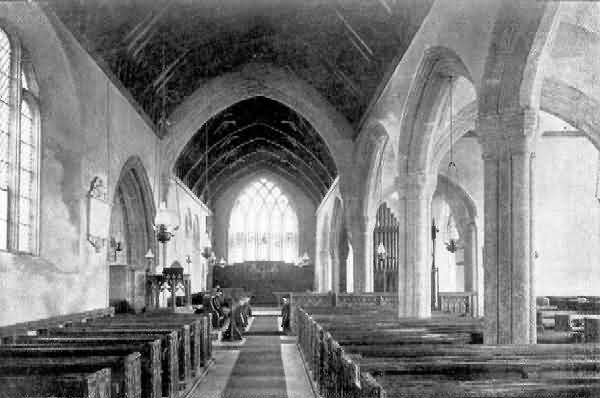
Beer Ferrers: Interior
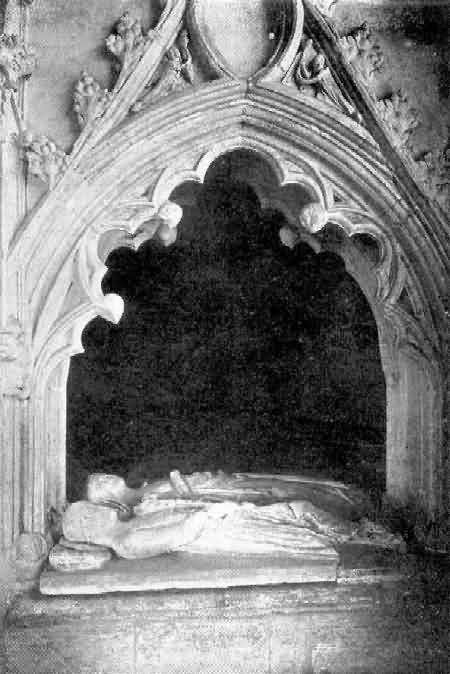
Beer Ferrers: Ferrers Monument
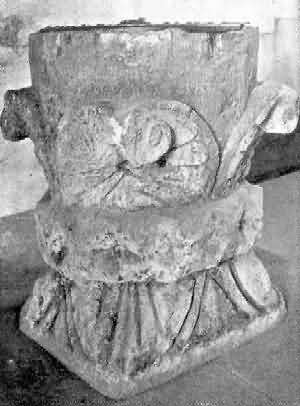
Beer Ferrers: Font
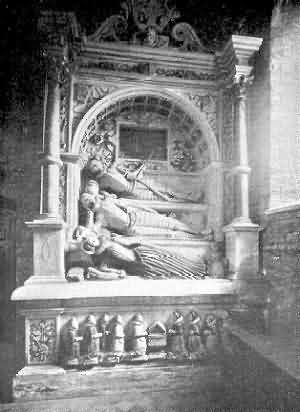
Berry Pommeroy: Seymour Monument
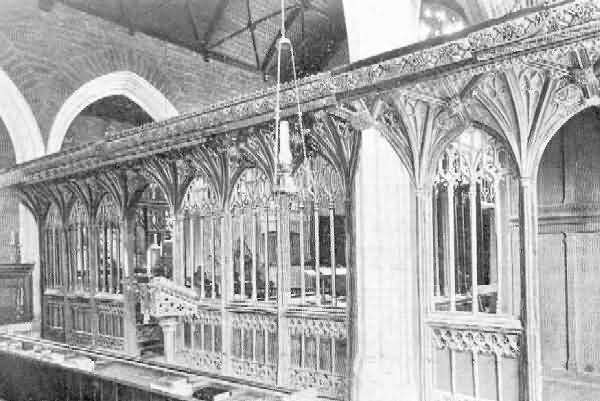
Berry Pommeroy: Rood Screen
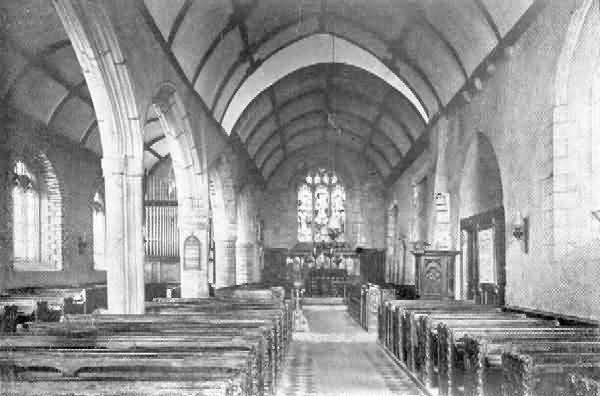
Bickington, High: Interior
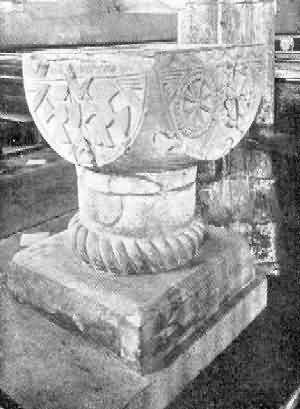
Bickington, High: Font
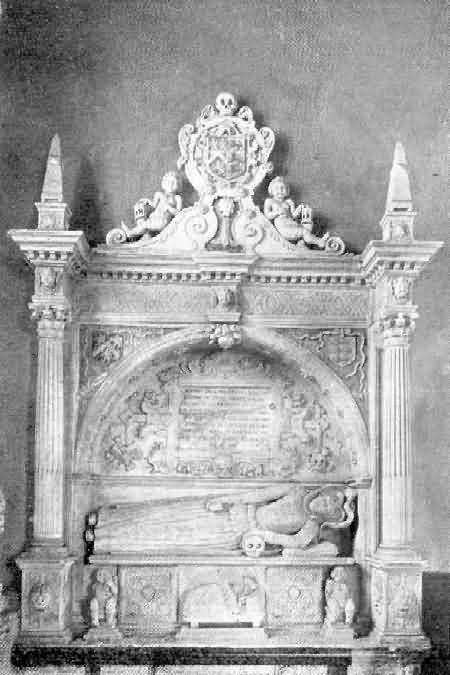
Bickleigh: Eriseye Monument
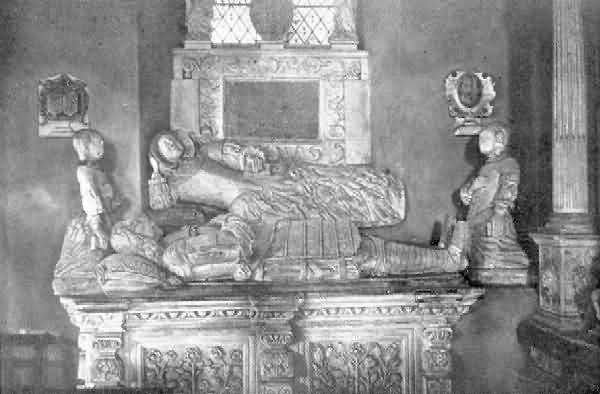
Bickleigh: Sir Henry Carew Monument
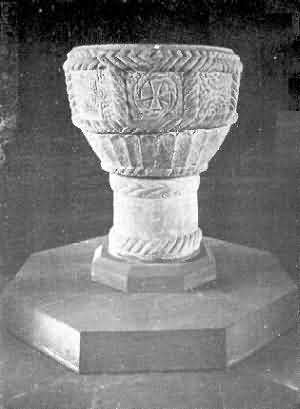
Bideford: Font
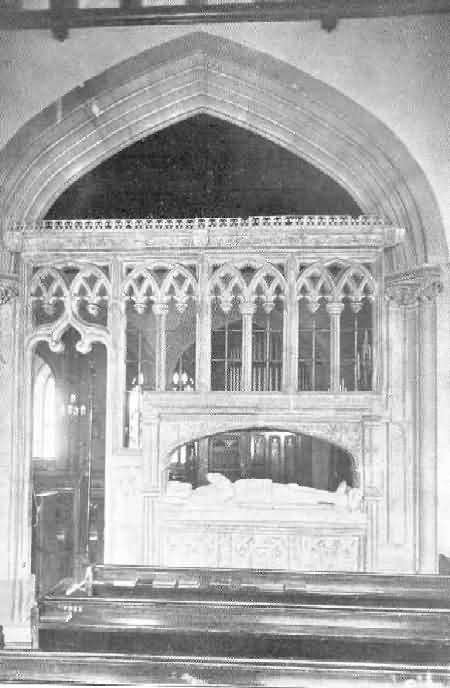
Bideford: Granville Monument
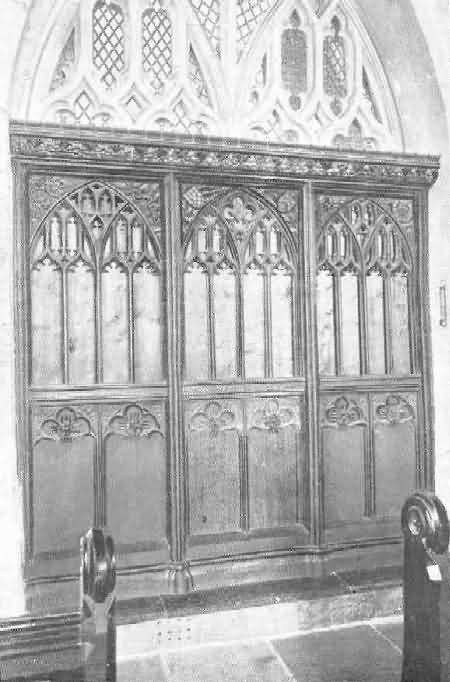
Bishop's Tawton: North Aisle Screen
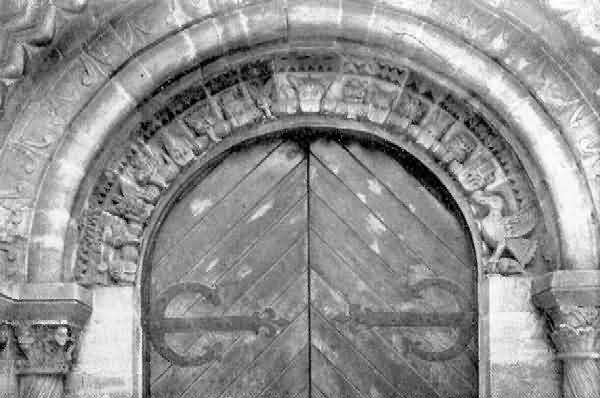
Bishopsteignton: Arch of West Doorway
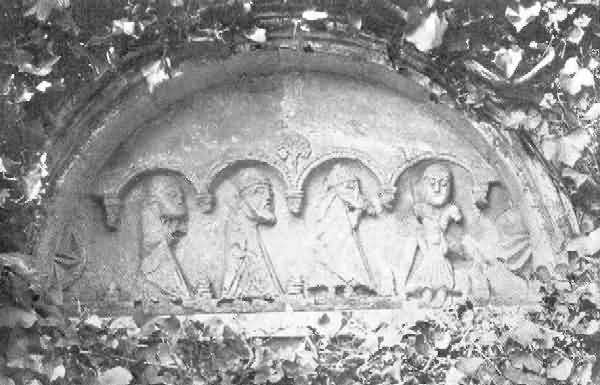
Bishopsteignton: Tympanum of South Doorway
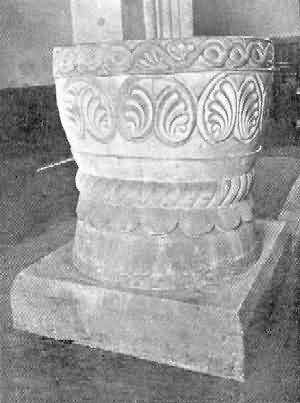
Bishopsteignton: Font
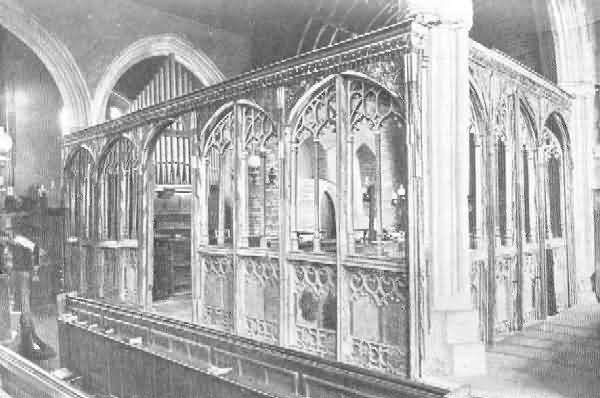
Blackawton: Rood Screen
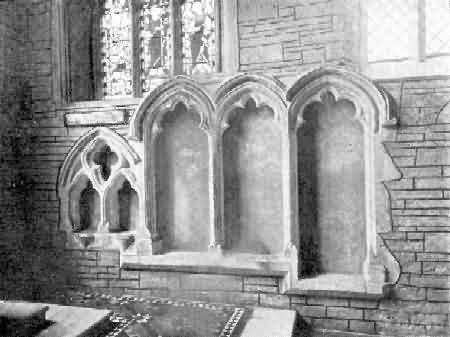
Blackawton: Piscina and Sedilia
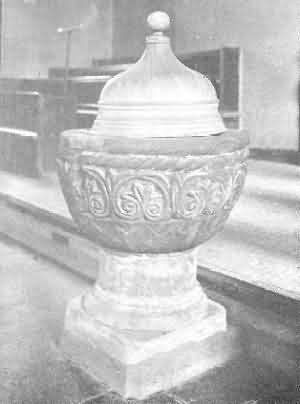
Blackawton: Font
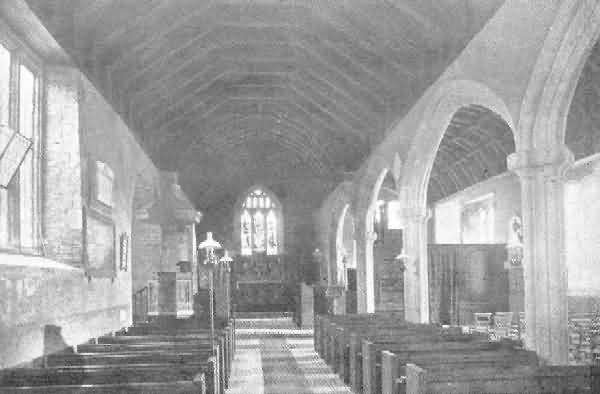
Black Torrington: Interior
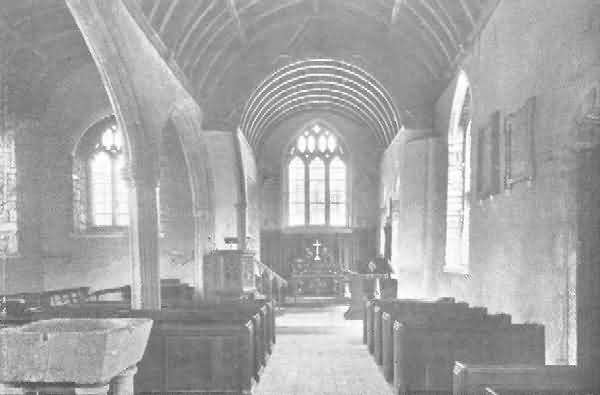
Bondleigh: Interior
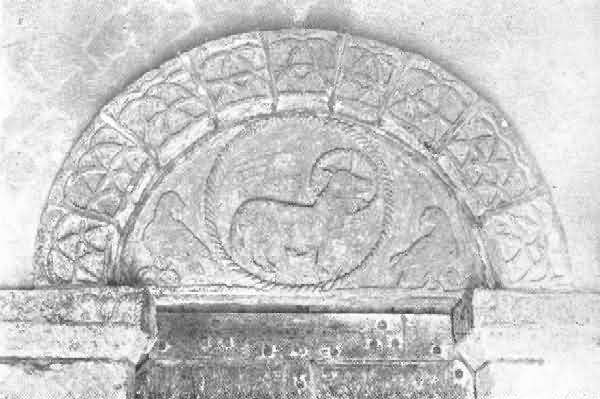
Bondleigh: Norman Tympanum
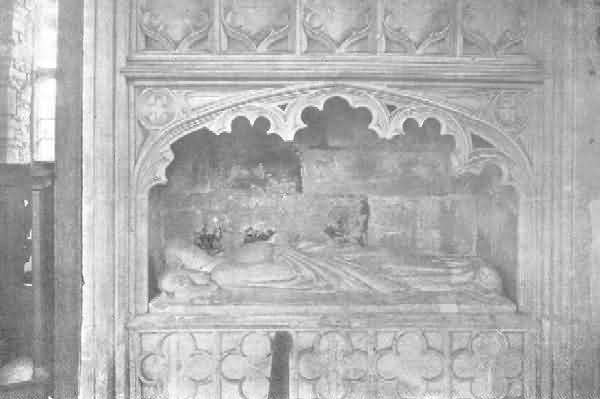
Bondleigh: Tomb in Chancel
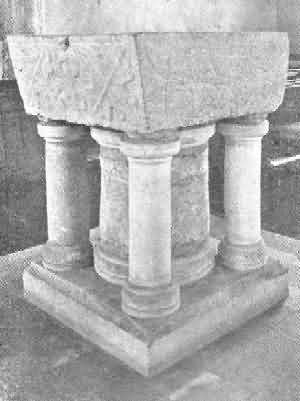
Bondleigh: Font
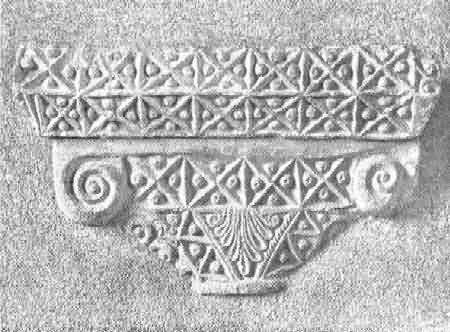
Bondleigh: Norman Capital
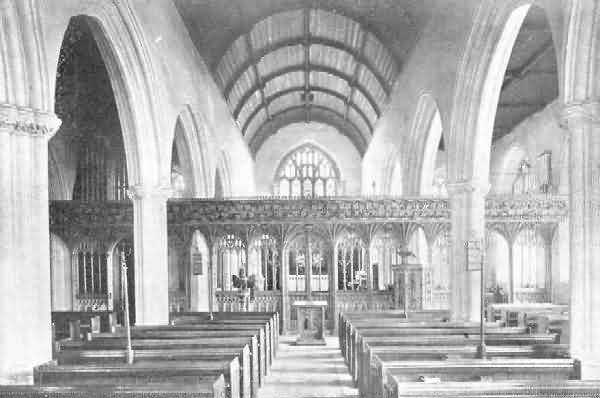
Bovey Tracey: Rood Screen
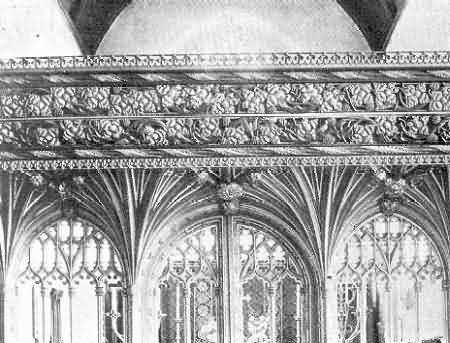
Bovey Tracey: Detail of Carving of Cornice
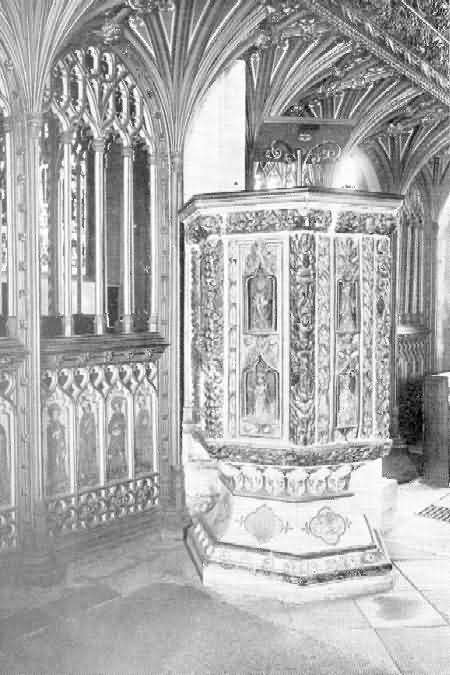
Bovey Tracey: Pulpit
«Some Old Devon Churches»:
Index; 25-36
[Dr. R. Peters: rpeters@wissensdrang.com]